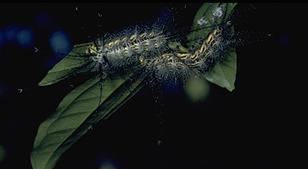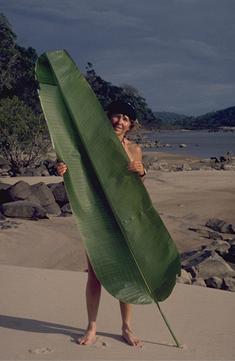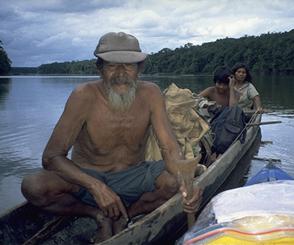RIO CARONI EXPEDITION


Wild things on the way.


Venezuela’s Lost World
by Ken McCarthy
We stood on top of a huge boulder looking out over the river, or what was supposed to be a river. The view was like something out of an Indiana Jones Movie. I could almost picture the lost temple full of hidden treasures out in the tangle of vines, trees and rocks. My wife Jen and I weren't looking for lost temples or treasures, just some way to get down the river. We had spend 2 years and thousands of dollars planning this first ever decent of the Caroni River and here only 50 miles into our 600 mile journey we found ourselves virtually at a stand still.
The river cut it's way between 2 mountains and in doing so had become a boulder sieve, almost unrecognizable as a river. We had spent the last 7 day battling our way through tropical jungles and over massive rock piles carrying our kayaks and several hundred lbs of gear, making less than a kilometer per day. It wasn't supposed to be like this yet. The hard part wasn't supposed to come for another hundred miles.
Having already over come the obstacle of getting 2 fourteen and a half foot long kayaks and hundreds of pounds of food and gear from our home in Utah, across the country to Miami, on the airplane, through customs and then across Venezuela to the start of the river, we were ready for some smooth sailing.
The summit was a magical place
We had spent 5 days climbing Roraima, the 9,210 foot high tepui. We left the boats behind for this part of the journey although at one point I was wishing we had them with us. The dry season was late in coming this year and the additional rains had made the Rio Cuquenán raise above it’s normal high. We searched the river for a place calm enough to get across, a small pool in the mist of the froth and foam of the white water. At six feet two inches tall, I was just able to wade the river with my backpack balanced on my head. Jen at 5’ 4” had to swim while I carried her pack across.
The summit was a magical place of fog, crystals and strange shaped rock formations. The plant life is like no where else on earth, with more than 7 different kinds of carnivorous plants. Many of the plants and animals don’t exist anywhere else on earth.
The first 4 days on the river went well. We paddle along on calm waters with a few small rapids. We saw multitudinous of exotic bird and animals as we glided quietly down the river. We were in heaven. Then we entered this mass of boulders. On the 12th day on the river we finally came to the end of the boulders and the river opened up. We had spent 8 days going 8 miles. Once free of the boulders we were able to make good miles again, covering 18 to 25 miles a day.
A burrowing sand flea
For several days I had been noticing a painful spot on one of my toes. I finally decide I had to do something about. When we stop that evening I got out the first aid kit and my knife and sat down to operate. I thought it was maybe an ingrown toe nail. I slid the blade of my knife in along the side of my toe nail and pop. The end of my toe popped open and a bug and eggs oozed out. A burrowing sand flea.
As we paddled along a quiet stretch of river we noticed a small group of dugout canoes sliding along under the branches of the trees that over hung the river bank. The canoes pulled out from under the trees and came out to meet us, Pemon Indians. The Pemon are the indigenous people of the region. They live in family group along the quiet parts of the Caroni. An old man in the front of the biggest canoe greeted us and ask where we were going. Spanish is a second language to these people, as it is to us, so conversation was kept simple and to the point. They had a hard time understanding why we would be paddling our boats so far. The old man just shook his head slowly and said “muchos saltos, muy peligroso” (many waterfalls, very dangerous).
They were right in may ways we were playing a serious game. In this massive wilderness a simple fall could be deadly. There were just two of use and rescue was a long way off. We would pass within a days walk of an airstrip on day 16. But most of the time we were more then a week from help if we could find our way through the jungle. Just knowing that changed the way we looked at things. Rapids that we would think nothing of suddenly became very dangerous looking.
100 foot high waterfall called Salto Eutobarima.
By day 18 the river had grown to a sizable volume. We had started on just a small creek with a flow of only 200 cubic feet per second (CFS) but here the river was 11,000 CFS, about the size of the Colorado river flowing through the Grand Canyon in summer. According to the map we had come to the crux of the trip. The river steepens and becomes nearly constant whitewater, then in one magnificent drop it plunges a 100 foot into a deep narrow gorge. The waterfall was called Salto Eutobarima. Below the falls it pooled for just a moment before rushing on down the gorge, dropping at a rate of 200 feet per mile. The entire gorge, 6 miles long, would have to be portaged.
Befor the falls the river is flowing west. Then just at this point it turns south, makes a 180 degree turn and comes back north before continues on it’s westerly path. By cutting across the top of the “U” we could miss most of the difficult whitewater. We figured it would take us at least a week to cut a trail through the jungle and haul boats, paddles, tents, food and all the other gear over the hill and back down to the river. We set up a base camp beside the river and started into the jungle, machete in hand.
“It takes a strong spirit to live in the forest”
The Pemon have a saying, “It takes a strong spirit to live in the forest”. They spend much of their lives battling the jungle, trying to clear open space and then to keep it. They burn off the grasslands on a regular bases so the jungle won’t take it back. Being from Utah we are used to wide open spaces and we know very little about the jungle. It was dark and damp, vines and spider webs hang everywhere. In the thickest parts of the forest it is easy to travel because the upper canopy shuts out the light and little vegetation grows on the jungle floor. But where the sun comes through it is a mass of vegetation, impossible to penetrate.
It was easy to let my mind get carried away and scare the hell out of me. What is out there? Spiders, snakes, bugs, lions, poison plants and poky things. I was walking through the brush, suddenly something got me in the shoulder, like a bee sting right through my shirt. After looking at the stings I turned the leaves over to see what had gotten me. What I found was a couple of hairy caterpillars. They were about 2 inches long and they had hairy spines about 1 inch long. The spines are stingers. Just one more thing to worry about.
I was pulling the kayak though the brush, bumping over fallen logs etc. Suddenly Jen yelled “snake”! Out from under the log I had just stepped over she saw a long dark snake, a Bushmaster. There are at least 4 kinds of poisonous snakes in this jungle. Some, like the Bushmaster, are deadly poisonous. In many places the rootsare a tangled mass covering the ground. Then the dirt washes out from under the roots, leaves cover them, and then I come walking along, falling through, sticking my feet down between the roots. What if something were in there waiting to strike. We had a venom extractor but would it really do anything? It would be deadly serious to get bitten here. There was no way out.
Out of the frying pan into the fire
By the time we were back on the river I was more then ready to get out of the jungle. But it was a case of out of the frying pan into the fire. We had made it past the worst of the rapids but it was far from over. For the next two days we ran some of the biggest rapids I’ve ever seen. Some were so big and steep that we had to carry our boats around them but most we were able to run. We had to scout every inch. There were no books or guides saying class III and IV rapids for the next 10 miles. No one had ever done it before.
We carried our kayaks around one last waterfall and finally floated in flat water again. We were past the crux, now we just had to put in the miles. And a lot of miles at that. We had been on the river, now, for 26 days but we had covered less than half the 600 miles. We started with what we hoped would be 30 days worth of food. So far we had done well, we might even squeak out a few extra days on the food we had. We hadn't had much luck with fishing so far but there was little incentive until the food runs out. We stopped at Indian villages along the way and bought bananas, pineapples, sugar cane and casava. Casava is one of the mainstays of the Pemon diet. It's made from the yuca root. It is kind of a giant flat bread, not bad with peanut butter on it.
Illegal gold miners on the Caroni
One afternoon as we paddle along enjoying the relaxation of flat water kayaking we saw what looked like a house boat floating on the river. As we drew closer we could hear the chug chug of a diesel engine. We knew there were supposed to be illegal gold miners on the Caroni but we never expected them to be this far up river. We didn't know what to expect from them and were nervous as we pulled up along side the wooden structure. We were surprised to see them this far up the river but they were completely amazed at us. We were tourist in a region that didn’t have tourist. They invited us aboard and showed us how the dredging operation worked. Over the next 10 days we came across over 25 mining dredges and they were always friendly and happy to see us.
They told us of the town of Uriman some 100 miles down river were we could buy supplies. It was the supply point for all the miners up the river. There were no roads into Uriman. Everything there was either grown there or flown in by small planes. When we got to Uriman we each bought an ice cold soda. We had been purifying and drinking 80 degree river water for a month now and a cold drink was a grand treat. The food was very expensive in Uriman but we bought enough to get us to the end if we could keep moving at full speed.
There were numerous rapids and falls each day but few were a problem. Most could be run. The miners always mentioned the same waterfall down river, Salto Babas. In Pemon it means Crocodile Falls. It was a beautiful staircase drop with beautiful curls of glassy water spilling over it. It was an easy portage. We felt we had it made. We would be able to over come this final big obstacle and with only a few more days of paddling we would reach the Rio Orinoco, the end of our journey. Then almost immediately after Salto Baba we found ourselves over our heads in huge rapids once again. The Indians had told us that there were some rapids and the maps confirmed it but we had no idea it would be this continues and difficult.
Fear of the unknown
It was terrifing to look at the massive waveand water slamming against the rocks, but the worst was the fear of the unknown. What if it gets worst farther down? What if we can’t do it but we can’t get out either. What if????? We had a weeks worth of food left and about 100 miles to get back to civilization. At 25 miles a day that would be no problem. But we had been stopped by rapids and rocks for eight days up river. What if it happened again? That was an emotional night in the rain listening to the roar of the rapids, questioning the wisdom of our decision to undertake such an ambitious adventure.
In the morning we got up and started the long process of scouting and running rapids. We had to portage some but by mid-afternoon we had past through the worst of it and soon found ourselves happily spinning our paddles through glassy waters once again.
The villages were gone
The Venezuelan government build a dam on the Caroni River, forming the 8th largest man made lake in the world, Guri Reservoir. The turbines at the Guri Dam produces more electricity then any other dam in the world. The reservoir is nearly 80 miles long and, in places, is over 50 miles across, it’s a virtual ocean.
Jen and I are experience river runners but kayaking on an ocean isn’t our area of expertise. We had planned to hire a motor boat at one of the small villages along the upper end of the reservoir to carry us cross the lake. What we didn’t know was that only a few years before the dam had been raised and the new high water line had flooded all the villages into oblivion. There were no villages left. While searching for one of the nonexistent village we accidentally stumble across the only civilized outpost on the upper Guri, JESSIE PARKER’S PEACOCK BASS FISHING CAMP.
Jessies’ is a an American owned fishing camp where serious fisherman go to angle for the monstrous and mean peacock bass. Steve, part owner and operator of the camp was at least as surprised to see us paddle up to his wilderness fishing camp as the miners had been when we paddle up to their dredges. He had been in these parts for over 10 years and never had he heard of such a thing. Two green horns from the deseret paddle out of a no-mans-land and park on his doorstep. He was so impressed he put us up for some rest and relaxation for a couple days before motoring us cross the reservoir.
On March 30, Easter Sunday, we paddle our well used kayaks past the skyscraper buildings of Puerto Adaz and huge ocean going ships into the white muddy waters of the Orinoco River, the end of the Caroni and our journey.
The End